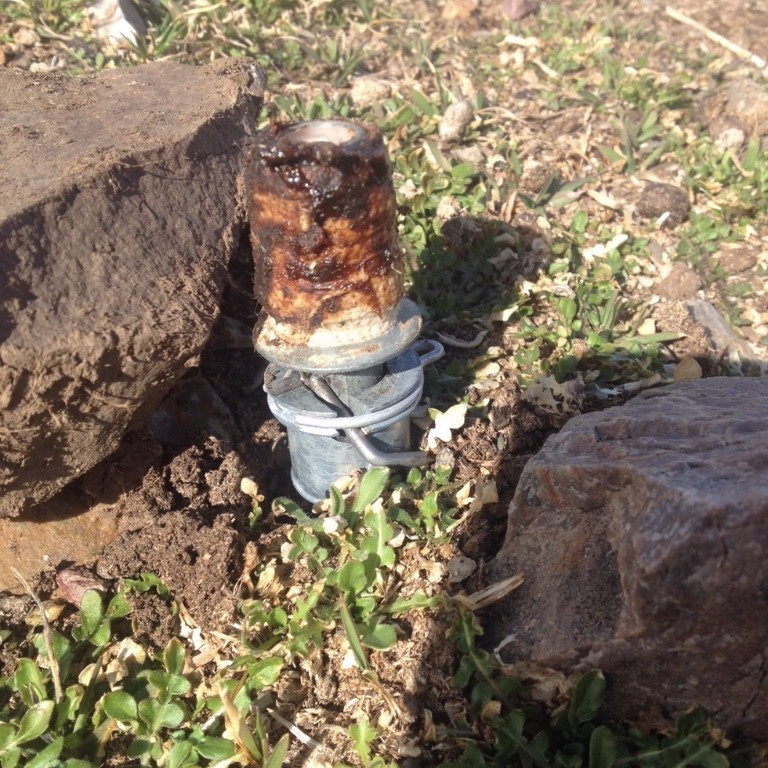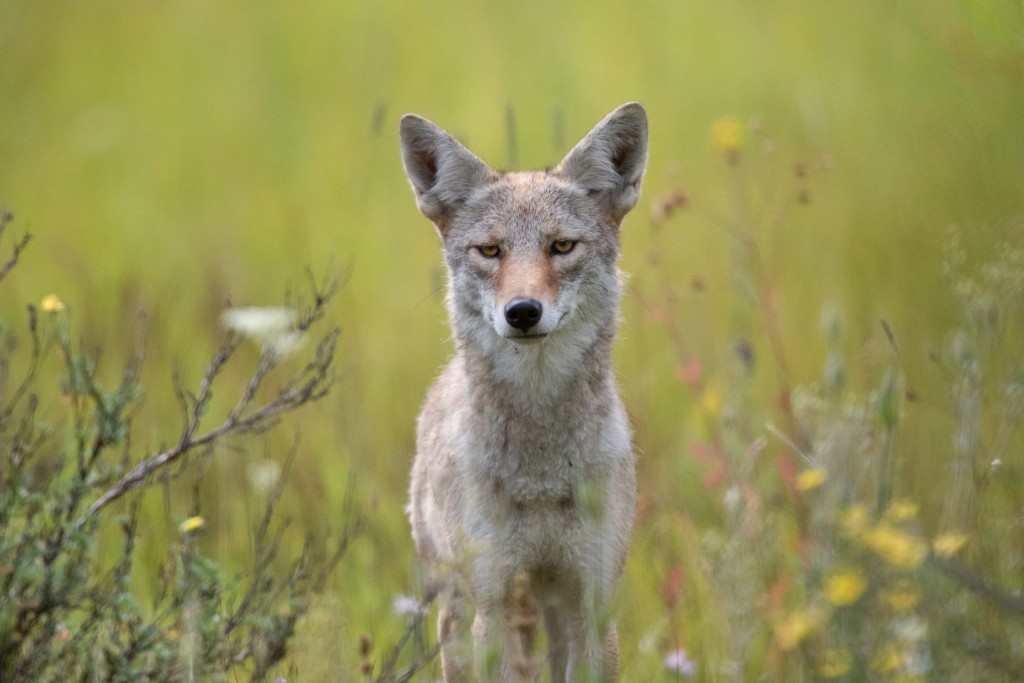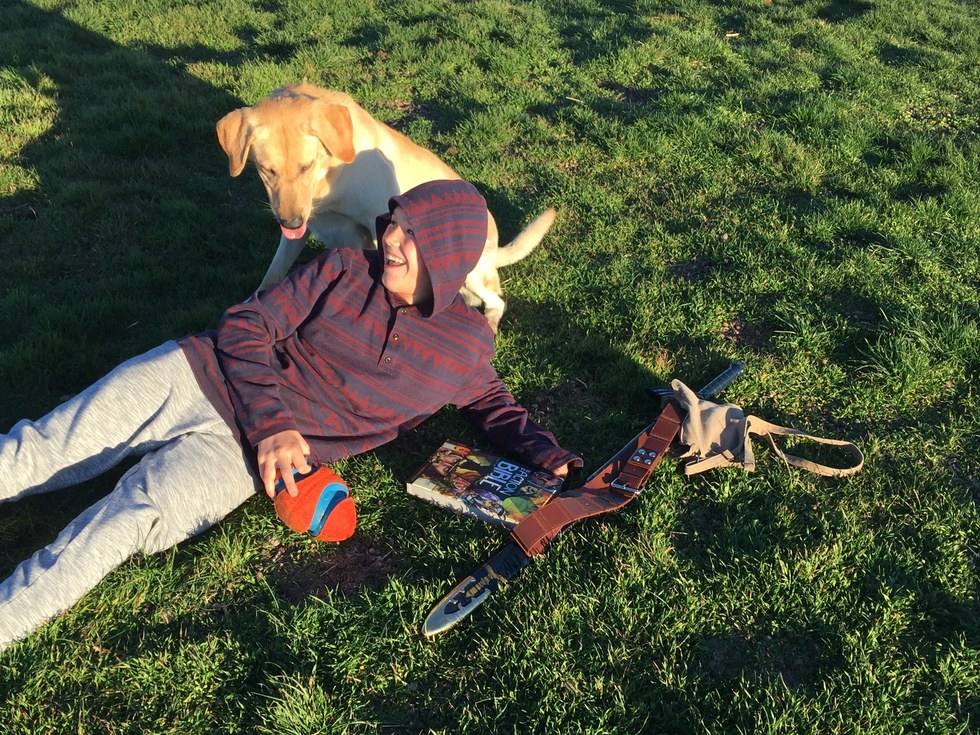Alert!
Halt the Use of Deadly M-44 "Cyanide Bombs"
- In the past two deadly years, three dogs have been killed by a device called a M-44 cyanide canister. These devices, which resemble a sprinkler head, are put out by Wildlife Services or certified county trappers to kill foxes and coyotes.
- On March 11, 2017 near Casper, Wyoming five people were out hiking with their four dogs in a frequently visited area. Abby, a 15-year old Drahthaar and Molly, a 7-year old Weimaraner were killed by an M-44 cyanide bomb 100 yards inside the boundaries of the private land.
- Another incident occurred on March 16, 2017 in eastern Idaho. A 14-year old boy, Canyon and his 3-year old dog Casey were on a walk behind their house when the boy bent down to look at the M-44 canister. The cyanide poison was ejected onto Canyon’s clothing and blew into Casey’s mouth. Casey was dead within minutes, and Canyon is lucky to be alive!
W
What is Wildlife Services?
Wildlife Services is a branch of the U.S. Department of Agriculture. Their website states: “The mission of USDA APHIS Wildlife Services (WS) is to provide Federal leadership and expertise to resolve wildlife conflicts to allow people and wildlife to coexist.”
Despite the mission of Wildlife Services to “allow people and wildlife to coexist,” the agency killed 2.7 million animals in 2016. Wildlife Services acts on both private and public land in the U.S. often at the request of livestock producers. Wolves, bears, coyotes, foxes, mountain lions, bobcats, birds, and many other types of wildlife are included in the target species.
M-44s are a spring-loaded device that contains sodium cyanide powder that is used to kill coyotes, foxes, and wild (feral) dogs. The device contains a capsule of sodium cyanide that reacts with the saliva in the animal’s mouth to produce hydrogen cyanide gas. When inhaled, the gas usually kills the animal within one to five minutes. Cyanide kills by binding to the iron in red blood cells and starving cells of oxygen. Cyanide poisoning causes seizures, rapid breathing, nausea, vomiting, feeling of neck constriction and suffocation, confusion, anxiety, fixed and dilated pupils, coma, and ultimately death.
When an animal bites and pulls on the cloth which contains a scent lure to attract the animal, the capsule breaks and the ejector is activated which causes the sodium cyanide to be propelled into the animal’s mouth. Wildlife Services is required to post signs warning the public of the presence of M-44 set in an area. However, no signs were present in the recent case in Idaho and the bombs were set within 350 yards of neighborhood homes.
Take Action
Please use your voice to ask for a halt to the use of these deadly M-44 cyanide bombs that are employed to kill predators and endanger our people and pets. Thank you!
Wyoming USDA APHIS Wildlife Services Office
Mike Foster
State Director/Wildlife Biologist
PO Box 67
Casper, Wyoming 82602
Office (307) 261-5336
Michael.D.Foster@aphis.usda.gov

- Office of Governor Mark Gordon
State Capitol
200 West 24th Street
Cheyenne, WY 82002-0010
Phone: (307)-777-7434
Fax: (307) 632-3909
governor@wyo.gov - U.S. Senator Mike Enzi
- U.S. Senator John Barrasso
- The Bureau of Land Management
William Perry PendleyDeputy Director, Policy & Programs, Exercising the Authority of the Director
Wyoming State Office
5353 Yellowstone Road
Cheyenne, WY 82009
Phone: 307-775-6526
Duane Spencer
Acting State Director
Fax: 307-775-6003
Phone: 307-775-6001
blm_wy_state_office_wymail@blm.gov
5353 Yellowstone Road
Cheyenne, WY 82009
Phone: 307-775-6526
Talking Points
Focus the energy of your words on banning M-44’s and the shifting tide to twenty-first-century wildlife management and public tolerance.
What you need to know
Wrap your own words around a spectrum of reasons to send M-44’s to the “gut pile”.
- As the tragedy involving the killing of two beloved family dogs near Casper, Wyoming and the death of a pet dog and the injury of a minor child near Pocatello, Idaho has shown, these devices are indiscriminate in their lethal effects, and cannot be rendered safe for non-target wildlife, domestic pets, and local residents. Federal and state agencies have no business turning lands, public or private, into potentially deadly minefields for the reported benefit of the livestock industry or any other reason.
- Cease all use of M-44 explosive cyanide devices, also known as “coyote getters” or “cyanide bombs,” on all land ownerships in the State of Wyoming, and immediately remove any and all M-44s currently deployed on all land ownerships in Wyoming.
- “We’re not at war with native wildlife, and it is irresponsible to allow poison landmines to be sown anywhere in Wyoming,” said Erik Molvar, executive director of Western Watersheds Project. “Wildlife Services got rid of M-44s in Idaho, and they should do the same in Wyoming before more pets, and even people, get hurt or killed.”
- “There is absolutely no reason for a government agency to be placing poisonous gas anywhere, much less mere yards from where people and pets live,” said Tara Zuardo, wildlife attorney with the Animal Welfare Institute. “Devices like these are not only extremely dangerous, but they also represent wasteful spending of taxpayer dollars and are the cause of tremendous suffering for both people and animals.”
- “The incredibly dangerous devices kill indiscriminately, and deaths of pets are common,” said Brooks Fahy, director of Predator Defense. “Unless there are witnesses, agencies often don’t record the poisonings. Families are than left to wonder what happened to their dog.”
- “Cyanide bombs are indiscriminate killers that must be banned,” said Andrea Santarsiere, a senior attorney with the Center for Biological Diversity. “Any animal that might pull on the baited trigger is at risk, including endangered wildlife like grizzlies, as well as people and pets. And in just the past few months, these cruel devices have injured a child and killed an endangered wolf and several family dogs. Enough is enough.”
- “Taxpayers should not be expected to continue funding the cruel slaughter of wildlife at the behest of agricultural producers’ profits,” said Stephen Wells, executive director of Animal Legal Defense Fund. “Cyanide bombs are indiscriminate and inhumane—and are a proven danger to humans and companion animals. These devices have no rightful place in wildlife policy.”
- “Many effective nonlethal alternatives exist to eliminate or reduce conflicts between livestock and predators,” said Camilla Fox, executive director of Project Coyote. “It’s time our federal government follow the lead of Washington, California and other states in banning these deadly poisons once and for all.”
- Given the serious negative impacts of predator killing programs on native wildlife, the unproven economic benefits (and in many cases, economic harms) of such programs for the livestock industry, and the clear and present danger that M-44 devices pose to people and their pets, the use of M-44s on public or private lands in Wyoming is unjustifiable and counter to the public interest. We call upon APHIS, Wildlife Services, and the Wyoming Department of Agriculture to clear all lands in Wyoming of these dangerous devices as expeditiously and urgently as possible, and to prohibit the future placement of such chemical weapons on any public or private lands.
- Wildlife Services restricts the use of M-44s in areas where wolves or grizzly bears are known to inhabit[1], however, the expansion of both wolf and grizzly bear territory makes it increasingly likely that these species will come in contact with, and be killed by, M-44s on both public and private lands. Earlier in 2017, for example, an M-44 killed a wolf in northeastern Oregon despite an agreement with state agencies that these types of lethal devices not be set in areas where wolves are known to roam. Since 2000, APHIS has reported deaths of at least 10 wolves by M-44s nationwide, including one death in Wyoming.[2]
[1] Wyoming Department of Agriculture. 2014. Using the M-44 in coyote damage control. Cheyenne, WY: Department of Agriculture, pp. 18-19.[2] USDA, Animal and Plant Health Inspection Service, “Wildlife Damage, Program Data Reports,” https://www.aphis.usda.gov/aphis/ourfocus/wildlifedamage/SA_Reports/SA_PDRs. - M-44’s are indiscriminate, killing non-target wildlife such as hawks and eagles, wolverines, lynx, and other species.[1] Since 2000, Wildlife Services has killed more than 50,000 individuals of more than 150 non-target species, including federally-protected and/or state-protected animals such as Mexican gray wolves, grizzly bears, kangaroo rats, eagles, falcons, California condors, red-tailed hawks, great horned owls, armadillos, pronghorns, porcupines, long-tailed weasels, javelinas, marmots, snapping turtles, turkey vultures, great blue herons, ruddy ducks, sandhill cranes, and ringtail cats.[2] During those 17 years, APHIS reported that 246,985 animals were reported killed by M-44s. APHIS reported that 8,365 animals from 32 species, including at least 1,182 dogs, were unintentionally killed by M-44s during that time period. [3]
[1]Marks, C.A., and R. Wilson. 2005. Predicting mammalian target-specificity of the M-44 ejector in south-eastern Australia. Wildl. Res. 32: 151-156.[2] Tom Knudson, Suggestions in Changing Wildlife Services Range from New Practices to Outright Bans, SACRAMENTO BEE (May 6, 2012).[3] USDA, Animal and Plant Health Inspection Service, “Wildlife Damage, Program Data Reports,” https://www.aphis.usda.gov/aphis/ourfocus/wildlifedamage/SA_Reports/SA_PDRs - Unfortunately, the APHIS reports are incomplete, notably missing data concerning deaths of domestic animals, pets and livestock known to have occurred during the reporting period. At least 38 pet dogs were killed by M-44s between 2000 and 2012, yet the APHIS program data reports reflect no deaths to domestic animals, pets and livestock during those years. Also, during that time, at least 11 people triggered M-44s and were directly exposed to cyanide, with some incidents resulting in serious injuries.
- Adding to the risks people and their pets face, M-44 applicators are not required to report the location of the devices to Wildlife Services or the WDA. The use restrictions mandate only that one other person in addition to the applicator know where the M-44s are placed and do not require the applicator to take, keep or report GPS coordinates of the location.
- In addition, the public is unable to obtain current information about where M-44s are located because the WDA does not receive a report on the number of devices, locations, dates of placement, discharges of the devices, species killed, or accidental injuries and deaths to humans and domestic animals until the month following use of M-44s. In those reports, the location of M-44s may be described by pasture name or another location identifier, instead of GPS coordinates, making the devices difficult to track.
- Wildlie Services’ and WDA’s predator killing programs are potentially counterproductive. Neither APHIS nor Wildlife Services, nor indeed anyone else, has ever demonstrated conclusively that the killing of native carnivores results in any reduction in livestock losses or impacts to other wildlife species. Nonselective predator killing methods (like M-44s) do not reduce losses of domestic sheep to predators.[1] In some cases, predator killing programs actually result in increased livestock losses.[2] The Wyoming Game and Fish Department states on their predator control fact sheet[3] that “more often, predator control programs also reduce non-target bird and mammal populations and upset the ecological balance of the area, leading to compounded problems.” The fact sheet also states that the M-44 “has obvious dangers and a questionable history of effectiveness.”
[1] Conner, M.M., M.M. Jaeger, T.J. Weller, and D.R. McCullough. 1998. Effect of coyote removal on sheep depredation in northern California. J. Wildl. Manage. 62: 690-699.[2] Current methods and research needs. Wildl. Soc. Bull. 32: 1209-1218.Peebles, K.A., R.B. Wielgus, B.T. Maletzke, and M.E. Swanson. 2013. Effects of remedial sport hunting on cougar complaints and livestock depredations. PLOSone http://dx.doi.org/10.1371/journal.pone.0079713.[3] Wyoming Game and Fish Department. 1995. Predator control and wildlife. Habitat Extension Bulletin 57. - As to our knowledge, no agency has provided an economically rigorous-benefit analysis examining the value of the ecosystem services provided by predators, the taxpayer costs of predator-killing programs, and the reported value of livestock lost to predators occupying their native habitats.
- Predator control efforts that eliminate or suppress populations of apex predators upset the natural balance of ecosystems, and have the counterproductive effect of causing increases in mesopredator populations, which causes systemic ecological imbalances that depress populations of birds and other prey species.[1] In Wyoming, coyote control efforts in the name of sage-grouse conservation increased the numbers of foxes and other small predators that pose a significantly greater risk for sage-grouse.[2] This is a particularly relevant indirect impact of lethal predator control given the imperative throughout the western United States for conservation of sage-grouse populations.
[1] Rogers, C.M., and M.J. Caro. 1998. Song sparrows, top carnivores and nest predation: A test of the mesopredator release hypothesis. Oecologia 116: 227-233; see also Crooks, K.R., and M.E. Soulé. 1999. Mesopredator release and avifaunal extinctions in a fragmented ecosystem. Nature 400: 563-566.[2] Mezquida, E.T., S.J. Slater, and C.W. Benkman. 2006. Sage-grouse and indirect interactions: Potential implications of coyote control on sage-grouse populations. Condor 108: 747-759. - For the period between 2000 and 2016, APHIS reported 5,973 target animals, 112 non-target animals (including 8 dogs), and 447 unclassified animals killed by M-44s in Wyoming. In addition, at least two dogs have been killed so far in 2017. The number of dogs that have been inadvertently killed during this timeframe is completely unacceptable given the ineffectiveness of predator control.
- Wildlife Services is responsible for approving all orders for M-44s. Non-WS applicators order M-44s through the WDA, which then forwards the order to Wildlife Services. There are no regulations governing how many M-44s an applicator can receive at one time. Only applicators employed by Wildlife Services can legally place M-44s on federal land with private and commercial applicators permitted to place M-44s on private and state land in Wyoming. The WDA licenses all applicators, including those employed by Wildlife Services. However, Wildlife Services applicators do not require approval from the WDA once the WDA issues their licenses. Conversely, the USDA only oversees purchases of the M-44 by non-WS private and commercial applicators, after which the WDA becomes solely responsible for oversight of the non-WS applicators’ use of the M-44s. These dual roles necessitate immediate action by both entities to ban the use of M-44s in Wyoming.
- All people, pets and wildlife should have a reasonable expectation for safety on our public lands, which means eliminating all M-44’s.
- There is a growing debate about the legitimacy of M-44’s on public lands which shows that a shift is coming. These deadly devices are no longer acceptable by a growing modern population.





